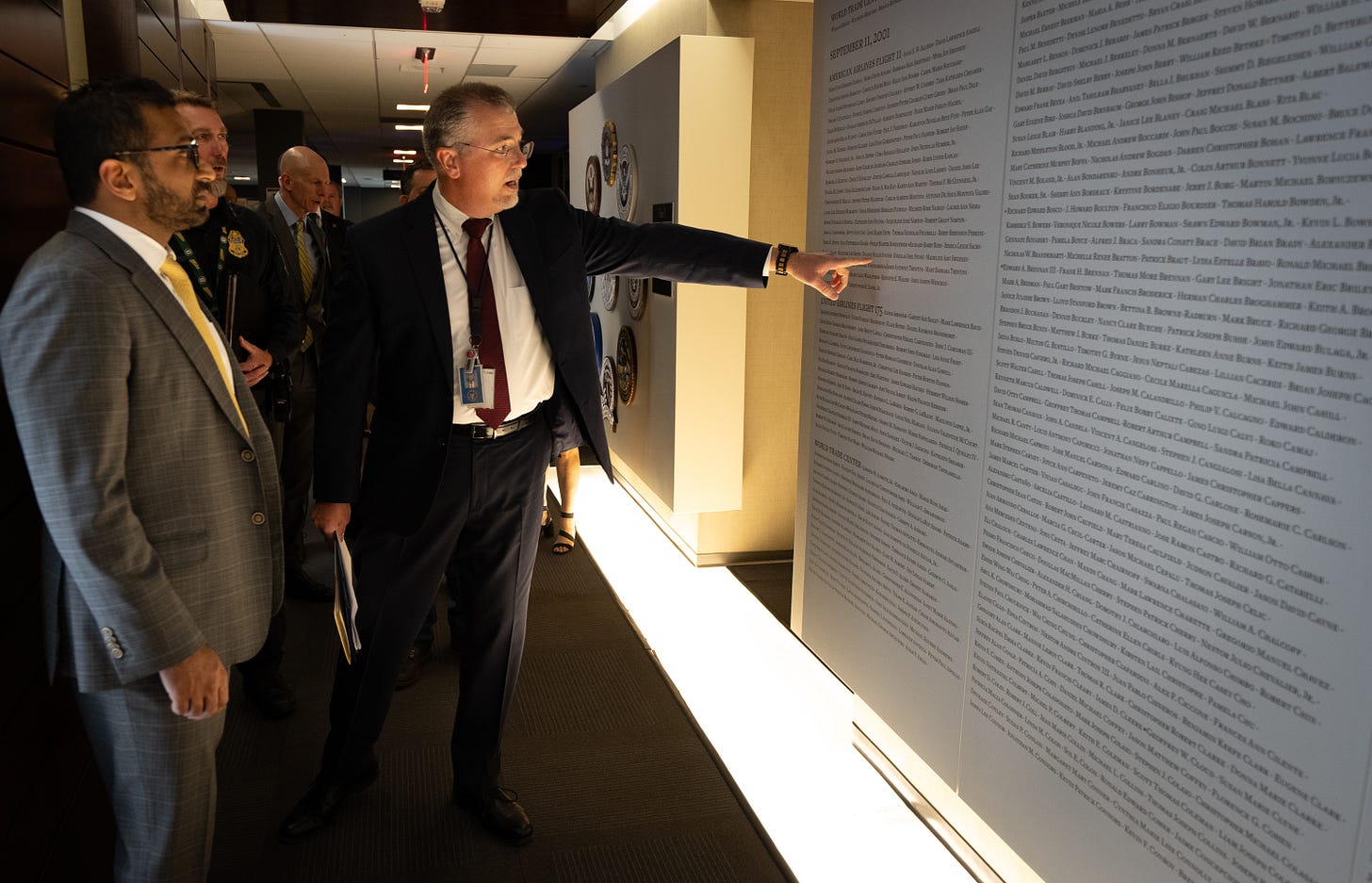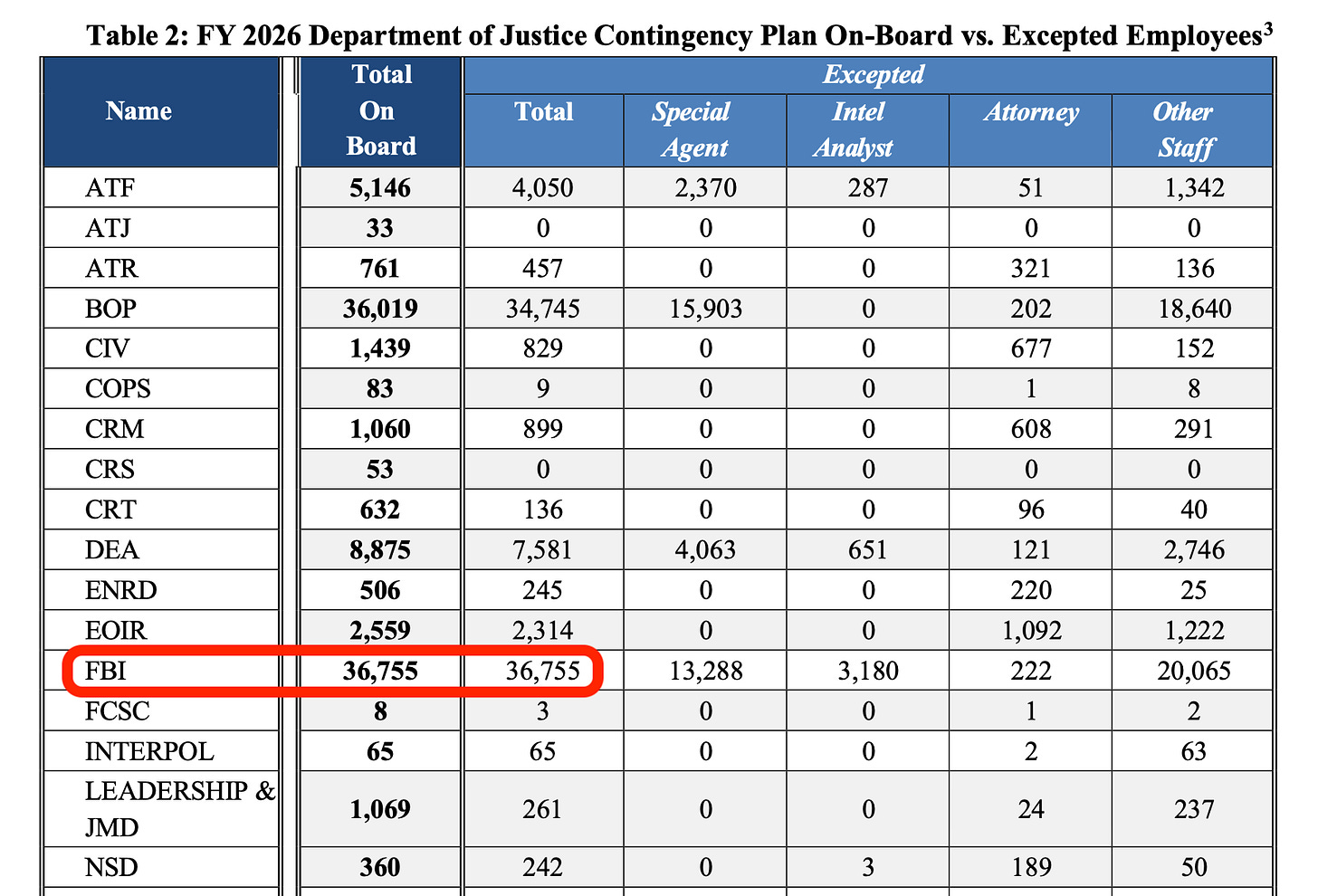Secretive Watchlisting Center Executing NSPM-7
“We’re expanding the watchlist,” FBI director says amid 300% increase in domestic terror investigations.
As the federal government begins to implement President Trump’s new national security directive to investigate the so-called radical left as domestic terrorists, a little known FBI organization, located in an affluent and leafy suburb of Northern Virginia, is at the center of it all.
Based just seven miles from CIA headquarters, the Threat Screening Center has a secret budget and a classified personnel count. The nondescript cluster of glass-fronted buildings has no sign out front. Even the identity of its director — FBI executive Steven McQueen, I’m told — isn’t public. (Until now.)
Behind a black fence and manicured berms, the Threat Screening Center maintains the federal government’s terrorist watchlist, created in response to the 9/11 attacks.
Today the FBI-run center is chewing on National Security Presidential Memorandum 7 (NSPM-7), Trump’s sweeping policy directive that formally directs the national security state to root out left-wing political violence by monitoring so-called indicators of violence, like “anti-Christianity,” “anti-capitalism” and “anti-Americanism,” as I’ve reported.
Though the text of NSPM-7 is public, the Threat Screening Center’s watchlisting process is a black hole. Even the criteria for how people end up on it is secret.
When Donald Trump took office, terrorist watchlist contained records of approximately 1.1 million persons, the overwhelming majority of whom were foreigners. Of that number, according to government documents I reviewed, under 6,000 (roughly half of one percent) were “U.S. persons,” defined both as American citizens and permanent residents.
A well-connected intelligence official tells me that most are Muslims suspected of desire or intent to commit “lone-wolf” attacks.
“The idea of a domestic watchlist, made up solely of radicals without foreign connections, left or right wing, is basically wrong,” the intelligence official said. He explained that many individuals might be the subject of specific investigations relating to violations of law, and there are a number of mechanisms by which the government keeps tabs on them to discover indicators of violence (and foreign connection) but up until Trump, a watchlist for Americans had never really gotten much traction.
“Is Ken Klippenstein, or any other American dissenter on the watchlist?” the official asks rhetorically. “No, and there really is no legal way for such a person to even be surveilled, let alone watchlisted, without legal predicate” — that is, without evidence that that the person has committed, or is about to commit, a crime.
“You might think that ‘about to commit’ is a loophole, but up until NSPM-7, it wasn’t,” the intelligence official said. He went on to explain that a combination of post-Watergate reforms, Congressional actions after mass-surveillance and Snowden revelations, and the FBI’s own rules, had created a web of limits.
“Until now,” he said.
Unfortunately, the official continued, changes made under President Obama and Biden paved the way for the Trump expansion. First was the addition of transnational organized crime to the watchlist and second was an affirmation that the terrorist watchlist wasn’t just about terrorists anymore.
“At least not terrorists as defined by al Qaeda or ISIS,” the official said.
Then in the final weeks of the first Trump administration in 2021, the FBI quietly changed the name of the Terrorist Screening Center to the Threat Screening Center to formalize the expanding mission. But when Biden came into office just days later, the Bureau quietly changed the name back. This back-and-forth was never reported.
Then in March of this year, the Trump administration announced with little fanfare that the Terrorist Screening Center would (again) change its name to the Threat Screening Center. The reason, the administration said, was that threats had evolved beyond familiar terrorist organizations — to encompass a broader range of “national security threats” not further explained.
“As national security threats continue to evolve, the TSC has expanded beyond terrorism watchlisting and screening to address other national security threats,” the announcement said. “With expanding and growing threats, we are reflecting that in our name … The name change is a signal to the American people that the TSC is a powerful tool that can be used to fight all national security threats.”
“We’re expanding the watchlist,” FBI director Kash Patel added to the announcement. “This change will assist our law enforcement and Intelligence Community partners as we all work together toward the goal of crushing violent crime within our borders.”
In May, in a rare public reference to the Center, Patel announced that he had spent a weekend there and that beefing it up the Center one of the first things he did after becoming FBI director.
“One of the first things we did when I was sworn in as director was to strengthen the TSC’s focus on border security, in addition to growing threats abroad,” Patel said on X. “Our team has done tremendous work in this area.”
Included in Patel’s post were photos of him at the Center alongside its then-director Michael Glasheen.
Within days, Glasheen was reassigned and a new head of the Threat Screening Center appointed. The new director, I’m told, is the FBI’s former deputy assistant director Steven McQueen, a longtime counterterrorism hand.
Asked for comment about the name of the director, the budget, and the number of people working there, the FBI declined comment, citing the government shutdown. (This despite the fact that the FBI is completely exempt from the shutdown, according to the Justice Department.)
“During the current lapse in appropriations, FBI operations are directed toward national security, violations of federal law, and essential public safety functions,” the Bureau told me.
Patel, in the announcement of his visit, went on to describe the Center’s mission as circulating watchlist information across the government “so that we’re better equipped to crush violent crime” — an objective that the Trump administration seems to be emphasizing more today than ever before.
Shortly after the murder of Charlie Kirk, Patel testified to Congress that he had overseen a 300% increase in domestic terrorism investigations. A large chunk of that increase, he said, is comprised of cases under the new designation “Nihilistic Violent Extremism,” a broad category that the administration plans to use to go after perceived adversaries, as I’ve reported.
At the Oval Office signing of NSPM-7, Trump’s homeland security advisor Stephen Miller made clear that the target of the directive (and the national security apparatus it is directing) was the political left.
“This is the first time in American history that there is an all-of-government effort to dismantle left wing terrorism.”
Over the past several days, Miller has gone even further, labeling everything from shootings lacking any clear partisan motive to attempts to physically obstruct ICE as terrorism.
“There is a large and growing movement of leftwing terrorism in this country,” Miller said this weekend. “The only remedy is to use legitimate state power to dismantle terrorism and terror networks.”
Doing that is a logistical feat, with the Threat Screening Center playing a central role.
“It might not be immediate, how the FBI creates the protocols and rules to create a whole new category of people to watchlist,” the intelligence official told me. “But as the Joint Terrorism Task Forces take up the charge at the local level, they will look to the TSC to internally organize and administer the new category of threats, even as the administration continues to misuse the term ‘terrorists.’”
— Edited by William M. Arkin





You're doing great work, Ken! I am happy that I can support you
Q: why don't the Democrats fight against these police state programs?
A: who do you think got the ball rolling? Why would they fight their own program?